ฟังก์ชั่นหลักของอิเล็กโทรดกราไฟท์คือการนำไฟฟ้าอิเล็กโทรดเมื่อทำการถล่มโลหะในเตาอาร์คไฟฟ้า. เนื่องจากสัดส่วนที่เพิ่มขึ้นของเหล็กหลอมในเตาอาร์คไฟฟ้าทั่วโลก, การใช้เตาอาร์คไฟฟ้าในการหลอมแผ่นเหล็กและเหล็กก่อตัวรองอื่น ๆ เป็นรายการหลักที่ใช้ขั้วไฟฟ้ากราไฟท์. นอกจากนี้, อิเล็กโทรดกราไฟท์ยังใช้ในการหลอมเตาเผาเพื่อละลายโลหะที่ไม่ใช่เหล็กและเซรามิกส์และในอุตสาหกรรมการรีไซเคิลขยะ.
หัวนมอิเล็กโทรดกราไฟท์คืออะไร?
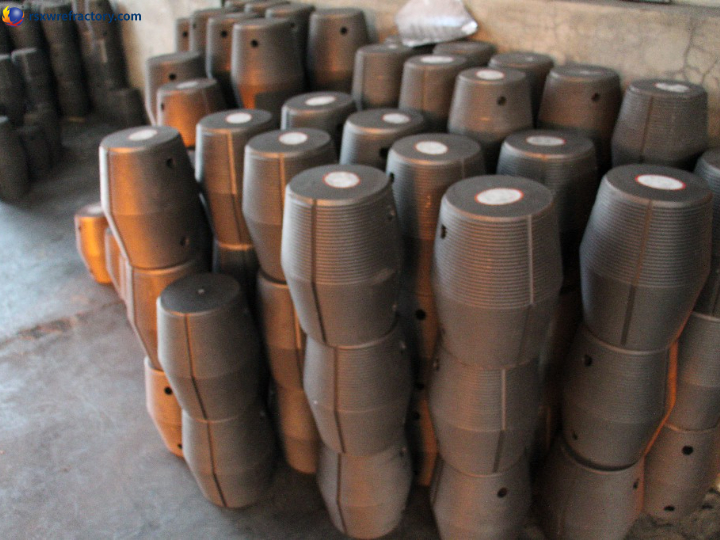
ข้อต่ออิเล็กโทรดกราไฟท์เป็นอุปกรณ์เสริมสำหรับอิเล็กโทรดกราไฟท์. อิเล็กโทรดกราไฟท์โดยทั่วไปมีข้อกำหนดที่สูงขึ้นสำหรับข้อต่อ. ข้อต่อโดยทั่วไปมีกระบวนการผลิตพิเศษ, ซึ่งสามารถแบ่งออกเป็น (ข้อต่ออิเล็กโทรดกราไฟท์พลังงานธรรมดา, ข้อต่ออิเล็กโทรดกราไฟท์พลังงานสูง, และข้อต่ออิเล็กโทรดกราไฟท์ที่มีกำลังสูงเป็นพิเศษ). ขั้วไฟฟ้ากราไฟท์และหัวนมมีข้อดีของความแข็งแรงสูง, ไม่ใช่เรื่องง่ายที่จะทำลาย, และการผ่านปัจจุบันที่ดี.
พารามิเตอร์ทางเทคนิคของอิเล็กโทรดกราไฟท์
ขั้วไฟฟ้ากราไฟท์
| รายการ | เส้นผ่านศูนย์กลางเล็กน้อยมม. | ||||||||||
| 75~ 130 | 150~ 225 | 250~ 300 | 350~ 450 | 500~ 800 | |||||||
| ระดับ | ยอดเยี่ยม | หนึ่ง | อดีต | หนึ่ง | อดีต | หนึ่ง | อดีต | หนึ่ง | อดีต | หนึ่ง | |
| ความต้านทาน μΩ· M ≤ | ขั้วไฟฟ้า | 8.5 | 10.0 | 9.0 | 10.5 | 9.0 | 10.5 | 9.0 | 10.5 | 9.0 | 10.5 |
| ตัวเชื่อมต่อ | 8.0 | 8.0 | 8.0 | 8.0 | 8.0 | ||||||
| MPA ความแข็งแรงของแรงดัดโค้ง≥ | ขั้วไฟฟ้า | 10.0 | 10.0 | 8.0 | 7.0 | 6.5 | |||||
| ตัวเชื่อมต่อ | 15.0 | 15.0 | 15.0 | 15.0 | 15.0 | ||||||
| GPA โมดูลัสยืดหยุ่น≤ | ขั้วไฟฟ้า | 9.3 | 9.3 | 9.3 | 9.3 | 9.3 | |||||
| ตัวเชื่อมต่อ | 14.0 | 14.0 | 14.0 | 14.0 | 14.0 | ||||||
| ความหนาแน่นจำนวนมาก g/cm3 ≥ | ขั้วไฟฟ้า | 1.58 | 1.53 | 1.53 | 1.53 | 1.52 | |||||
| ตัวเชื่อมต่อ | 1.70 | 1.70 | 1.70 | 1.70 | 1.70 | ||||||
| ค่าสัมประสิทธิ์การขยายตัวทางความร้อน 10-6/℃ อุณหภูมิห้อง ~ 600 ℃≥ | ขั้วไฟฟ้า | 2.9 | 2.9 | 2.9 | 2.9 | 2.9 | |||||
| ตัวเชื่อมต่อ | 2.7 | 2.7 | 2.8 | 2.8 | 2.8 | ||||||
| เถ้า % ≤ | 0.5 | 0.5 | 0.5 | 0.5 | 0.5 | ||||||
ขั้วไฟฟ้ากราไฟท์พลังงานสูง
| รายการ | เส้นผ่านศูนย์กลางเล็กน้อยมม. | |||
| 200~ 400 | 450~ 500 | 550~ 700 | ||
| ความต้านทาน μΩ· M ≤ | ขั้วไฟฟ้า | 7.0 | 7.5 | 7.5 |
| ตัวเชื่อมต่อ | 6.3 | 6.3 | 6.3 | |
| MPA ความแข็งแรงของแรงดัดโค้ง≥ | ขั้วไฟฟ้า | 10.5 | 10.0 | 8.5 |
| ตัวเชื่อมต่อ | 17.0 | 17.0 | 17.0 | |
| GPA โมดูลัสยืดหยุ่น≤ | ขั้วไฟฟ้า | 14.0 | 14.0 | 14.0 |
| ตัวเชื่อมต่อ | 16.0 | 16.0 | 16.0 | |
| ความหนาแน่นจำนวนมาก g/cm3 ≥ | ขั้วไฟฟ้า | 1.60 | 1.60 | 1.60 |
| ตัวเชื่อมต่อ | 1.72 | 1.72 | 1.72 | |
| ค่าสัมประสิทธิ์การขยายตัวทางความร้อน 10-6/℃ อุณหภูมิห้อง ~ 600 ℃≥ | ขั้วไฟฟ้า | 2.4 | 2.4 | 2.4 |
| ตัวเชื่อมต่อ | 2.2 | 2.2 | 2.2 | |
| เถ้า % ≤ | 0.5 | 0.5 | 0.5 | |
อิเล็กโทรดกราไฟท์พลังงานสูงเป็นพิเศษ
| รายการ | เส้นผ่านศูนย์กลางเล็กน้อยมม. | ||||
| 300~ 400 | 450~ 500 | 550~ 650 | 700~ 800 | ||
| ความต้านทาน μΩ· M ≤ | ขั้วไฟฟ้า | 6.2 | 6.3 | 6.0 | 5.8 |
| ตัวเชื่อมต่อ | 5.3 | 5.3 | 4.5 | 4.3 | |
| MPA ความแข็งแรงของแรงดัดโค้ง≥ | ขั้วไฟฟ้า | 10.5 | 10.5 | 10.0 | 10.0 |
| ตัวเชื่อมต่อ | 20.0 | 20.0 | 22.0 | 23.0 | |
| GPA โมดูลัสยืดหยุ่น≤ | ขั้วไฟฟ้า | 14.0 | 14.0 | 1.66 | 14.0 |
| ตัวเชื่อมต่อ | 20.0 | 20.0 | 1.78 | 22.0 | |
| ความหนาแน่นจำนวนมาก g/cm3 ≥ | ขั้วไฟฟ้า | 1.67 | 1.66 | 1.66 | 1.68 |
| ตัวเชื่อมต่อ | 1.74 | 1.75 | 1.78 | 1.78 | |
| ค่าสัมประสิทธิ์การขยายตัวทางความร้อน 10-6/℃ อุณหภูมิห้อง ~ 600 ℃≥ | ขั้วไฟฟ้า | 1.5 | 1.5 | 1.5 | 1.5 |
| ตัวเชื่อมต่อ | 1.4 | 1.4 | 1.3 | 1.3 | |
| เถ้า % ≤ | 0.5 | 0.5 | 0.5 | 0.5 | |
ประเภทของขั้วไฟฟ้ากราไฟท์
- อิเล็กโทรดกราไฟท์พลังงานธรรมดา: อนุญาตให้ใช้ความหนาแน่นกระแสต่ำ, ซึ่งโดยทั่วไปใช้ในเตาไฟฟ้าธรรมดาสำหรับการทำเหล็ก, การกลั่นซิลิกอน, การกลั่นฟอสฟอรัสสีเหลือง, ฯลฯ.
- อิเล็กโทรดกราไฟท์พลังงานสูง: อนุญาตให้ใช้ความหนาแน่นปัจจุบันของ 1.5-2 เท่าของขั้วไฟฟ้าพลังงานธรรมดา, ส่วนใหญ่ใช้ในเตาไฟฟ้าการผลิตเหล็กกล้าไฟฟ้าที่สูงขึ้น.
- อิเล็กโทรดกราไฟท์พลังงานสูงเป็นพิเศษ: ช่วยให้การใช้ความหนาแน่นกระแสสูงกว่าขั้วไฟฟ้าสูง, มีค่าการนำไฟฟ้าที่ดีกว่า, เสถียรภาพทางความร้อน, และความแข็งแรงเชิงกล, และใช้ในเตาไฟฟ้าไฟฟ้าสูงเป็นพิเศษ.
ลักษณะของขั้วไฟฟ้ากราไฟท์คืออะไร?
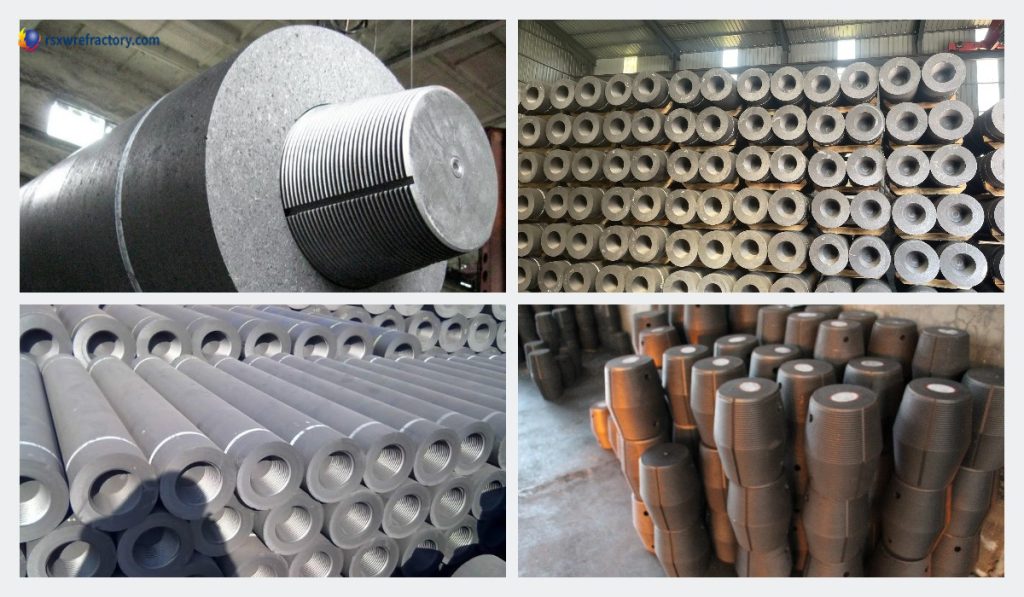
- ขั้วไฟฟ้ากราไฟท์มีค่าการนำไฟฟ้าสูง. กราไฟท์เป็นตัวนำที่ดี, และการนำไฟฟ้าเป็นอันดับสองเท่านั้น, และในบางแง่มุม, มันดีกว่าโลหะบางชนิด. ลักษณะนี้ทำให้อิเล็กโทรดกราไฟท์ใช้กันอย่างแพร่หลายในอุตสาหกรรมพลังงาน, อุตสาหกรรมอิเล็กทรอนิกส์, และสาขาอื่น ๆ.
- ขั้วไฟฟ้ากราไฟท์มีความเสถียรทางความร้อนสูง. กราไฟท์มีจุดหลอมเหลวที่สูงมากและสามารถรักษาเสถียรภาพของโครงสร้างและประสิทธิภาพในสภาพแวดล้อมที่สูงหรือสูงเป็นพิเศษ, ซึ่งทำให้อิเล็กโทรดกราไฟท์ใช้กันอย่างแพร่หลายในอุตสาหกรรมอุณหภูมิสูงเช่นการผลิตโลหะวิทยาอุณหภูมิสูงและการผลิตแก้ว.
- ขั้วไฟฟ้ากราไฟท์มีความเสถียรทางเคมีที่แข็งแกร่ง. กราไฟท์มีความต้านทานการกัดกร่อนที่ดีต่อกรดส่วนใหญ่, อัลคาลิส, และตัวทำละลายอินทรีย์, ซึ่งทำให้อิเล็กโทรดกราไฟท์ใช้กันอย่างแพร่หลายในอุตสาหกรรมเคมี, อุตสาหกรรมคุ้มครองสิ่งแวดล้อม, และสาขาอื่น ๆ.
- ขั้วไฟฟ้ากราไฟท์นั้นง่ายต่อการประมวลผล. กราไฟท์นุ่มและตัดง่าย, แกะสลัก, และรูปร่าง, ซึ่งทำให้อิเล็กโทรดกราไฟท์มีความยืดหยุ่นและสะดวกในกระบวนการผลิต.
กระบวนการผลิตอิเล็กโทรดเตาหลอม
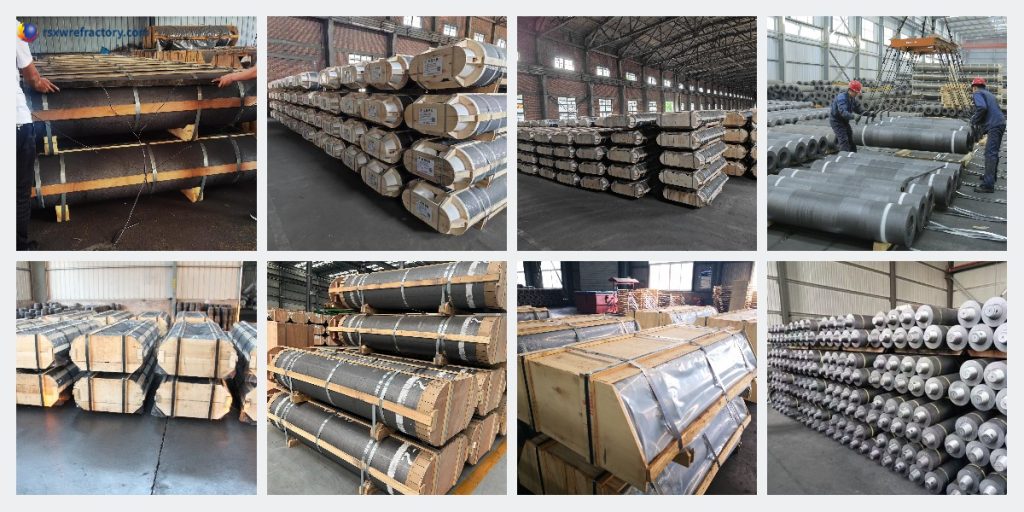
กระบวนการผลิตอิเล็กโทรดกราไฟท์ส่วนใหญ่รวมถึงขั้นตอนของการเลือกวัตถุดิบ, การแบตช์, การนวด, การปั้น, การคั่ว, และกราฟ.
ก่อนอื่นเลย, การเลือกวัตถุดิบเป็นขั้นตอนแรกในการผลิตอิเล็กโทรดกราไฟท์. วัตถุดิบของขั้วไฟฟ้ากราไฟท์ส่วนใหญ่เป็นโค้กปิโตรเลียมและพิทช์โค้ก. การเลือกวัตถุดิบเหล่านี้ส่งผลโดยตรงต่อประสิทธิภาพและคุณภาพของขั้วไฟฟ้ากราไฟท์. ประการที่สอง, การแบทช์คือการผสมของวัตถุดิบที่เลือกในสัดส่วนที่กำหนดเพื่อให้ได้ประสิทธิภาพที่คาดหวัง. กระบวนการแบทช์ต้องการการวัดและการควบคุมที่แม่นยำเพื่อให้แน่ใจว่าประสิทธิภาพที่มั่นคงของขั้วไฟฟ้ากราไฟท์. แล้ว, การนวดคือการผสมและนวดวัตถุดิบที่เตรียมไว้เพื่อสร้างส่วนผสมที่สม่ำเสมอ. กระบวนการนวดมีอิทธิพลสำคัญต่อความสม่ำเสมอและความหนาแน่นของขั้วไฟฟ้ากราไฟท์. ต่อไป, การปั้นคือการกดวัสดุนวดเพื่อสร้างรูปร่างเบื้องต้นของอิเล็กโทรดกราไฟท์. กระบวนการขึ้นรูปต้องการการควบคุมความดันและอุณหภูมิที่แม่นยำเพื่อให้แน่ใจว่ารูปร่างและขนาดความแม่นยำของขั้วไฟฟ้ากราไฟท์. แล้ว, การคั่วคือการรักษาความร้อนอิเล็กโทรดกราไฟท์ที่เกิดขึ้นที่อุณหภูมิสูงเพื่อให้โครงสร้างมีเสถียรภาพมากขึ้น. กระบวนการคั่วต้องมีการควบคุมอุณหภูมิและเวลาที่แม่นยำเพื่อให้แน่ใจว่าประสิทธิภาพและคุณภาพของขั้วไฟฟ้ากราไฟท์. ในที่สุด, กราฟิคคือการทำให้กราฟอิเล็กโทรดกราไฟท์อบที่อุณหภูมิสูงเพื่อให้กราฟได้มากขึ้นและมีประสิทธิภาพที่ดีขึ้น. กระบวนการสร้างกราฟต้องใช้อุณหภูมิสูงมากและใช้เวลาในการประมวลผลที่ยาวนานและเป็นขั้นตอนที่สำคัญที่สุดในการผลิตอิเล็กโทรดกราไฟท์.
การใช้ขั้วไฟฟ้ากราไฟท์
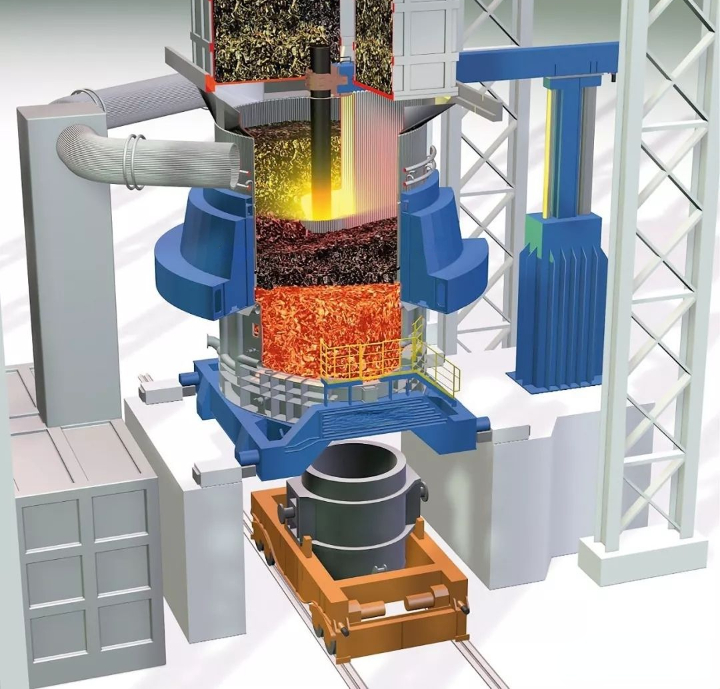
ขั้วไฟฟ้ากราไฟท์เป็นผลิตภัณฑ์คาร์บอนที่สำคัญ. พวกเขามีบทบาทในการดำเนินการไฟฟ้าและการถ่ายเทความร้อนในการผลิต. พวกเขาใช้วัสดุสิ้นเปลืองบนอุปกรณ์ถลุงเช่นเตาเผาเหล็กอาร์ค, เตาหลอมความร้อนแร่, เตาไฟฟ้า, และเตาเผาความต้านทาน.
อิเล็กโทรดกราไฟท์มีการใช้งานที่หลากหลายและส่วนใหญ่จะใช้กับอุปกรณ์การหลอมหลายชนิดเช่นเตาเหล็กอาร์ค, เตาหลอมความร้อนแร่, เตาไฟฟ้า, และเตาเผาความต้านทาน. เป็นวัสดุนำไฟฟ้า, ขั้วไฟฟ้ากราไฟท์มีบทบาทสำคัญในกระบวนการหลอม.
ในเตาเผาเหล็กอาร์ค, อิเล็กโทรดกราไฟท์สร้างส่วนโค้งอุณหภูมิสูงผ่านการนำไฟฟ้าเพื่อละลายประจุและบรรลุวัตถุประสงค์ของการทำเหล็กกล้า. ในเตาหลอมและเตาเผาไฟฟ้า, อิเล็กโทรดกราไฟท์ใช้ในการดำเนินการกระแสและสร้างพลังงานความร้อนเพื่อให้ความร้อนและละลายประจุ. นอกจากนี้, อิเล็กโทรดกราไฟท์ยังใช้กันอย่างแพร่หลายในสารเคมี, เกี่ยวกับโลหะ, เกี่ยวกับกลไก, เกี่ยวกับอิเล็กทรอนิกส์, และสาขาอุตสาหกรรมอื่น ๆ.
 กลุ่มหรงเฉิง
กลุ่มหรงเฉิง

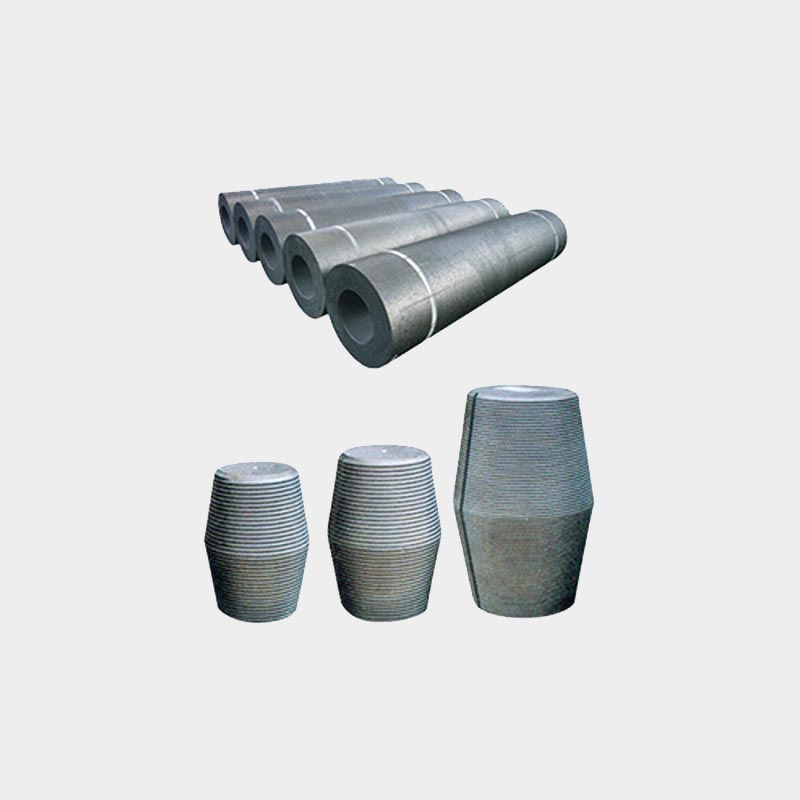
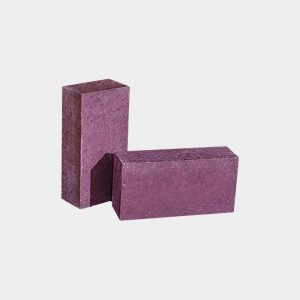
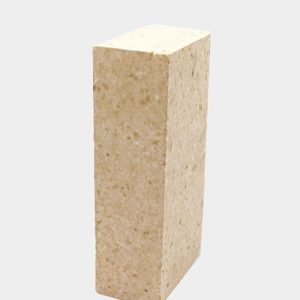
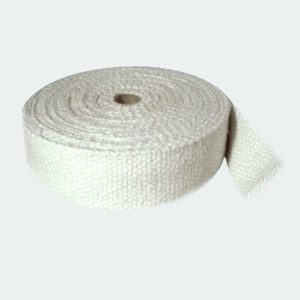
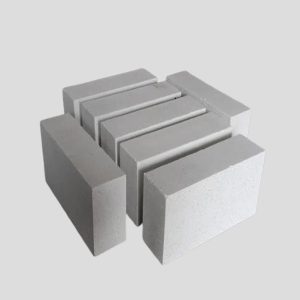
วีแชท
สแกนรหัส QR ด้วย wechat